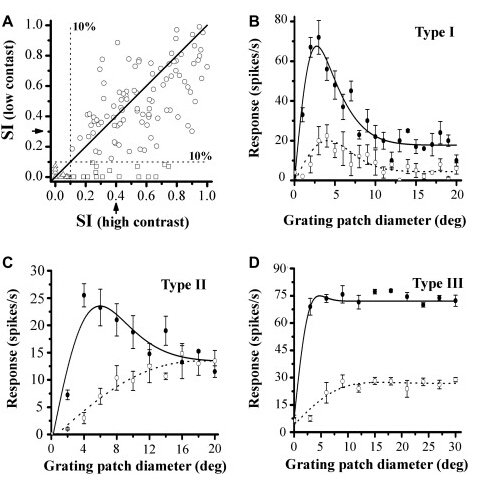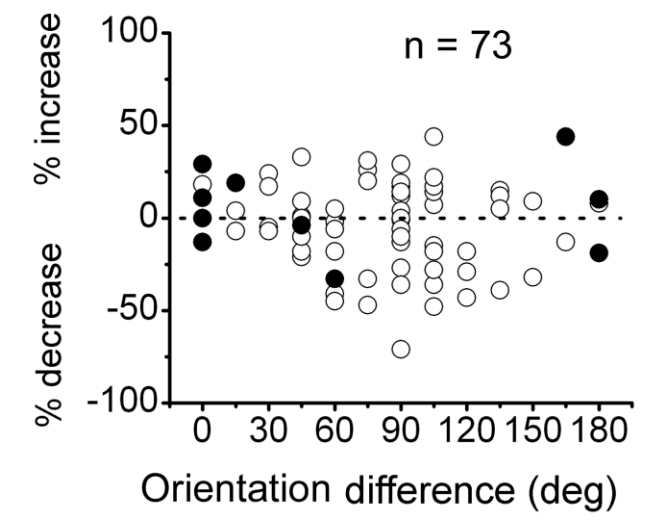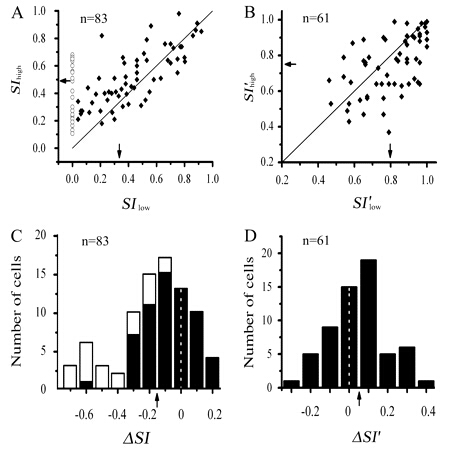Visual Neural Mechanism @ UESTC
Neural Coding, Electrophysiology, Optical Imaging
Publications:

Ke Chen, Xue-Mei Song, Zheng-Qiang Dai, Jiao-Jiao Yin, Xing-Zhen Xu, Chao-Yi Li. "The spatial summation characteristics of three categories of V1 neurons differing in non-classical receptive field modulation properties." Vision Research, 96:87–95,2014
The spatial summation of excitation and inhibition determines the final output of neurons in the cat V1. To characterize the spatial extent of the excitatory classical receptive field (CRF) and inhibitory non-classical receptive field (nCRF) areas, we examined the spatial summation properties of 169 neurons in cat V1 at high (20–90%) and low (5–15%) stimulus contrasts. Three categories were classified based on the difference in the contrast dependency of the surround suppression. We discovered that the three categories significantly differed in CRF size, peak firing rate, and the proportion of simple/complex cell number. The classification of simple and complex cells was determined at both high and low contrasts. While the majority of V1 neurons had stable modulation ratios in their responses, 10 cells (6.2%) in our sample crossed the classification boundary under different stimulus contrasts. No significant difference was found in the size of the CRF between simple and complex cells. Further comparisons in each category determined that the CRFs for complex cells were significantly larger than those for simple cells in category type I neurons, with no significant differences between simple and complex cells in category type II and type III neurons. In addition, complex cells have higher peak firing rates than simple cells.

Tao Xu, Ling Wang, Xue-Mei Song, Chao-Yi Li. "The Detection of Orientation Continuity and Discontinuity by Cat V1 Neurons." Plos One. 8(11), e79723, 2013.[pdf]
The orientation tuning properties of the non-classical receptive field (nCRF or "surround") relative to that of the classical receptive field (CRF or "center") were tested for 119 neurons in the cat primary visual cortex (V1). The stimuli were concentric sinusoidal gratings generated on a computer screen with the center grating presented at an optimal orientation to stimulate the CRF and the surround grating with variable orientations stimulating the nCRF. Based on the presence or absence of surround suppression, measured by the suppression index at the optimal orientation of the cells, we subdivided the neurons into two categories: surround-suppressive (SS) cells and surround-non-suppressive (SN) cells. When stimulated with an optimally oriented grating centered at CRF, the SS cells showed increasing surround suppression when the stimulus grating was expanded beyond the boundary of the CRF, whereas for the SN cells, expanding the stimulus grating beyond the CRF caused no suppression of the center response. For the SS cells, strength of surround suppression was dependent on the relative orientation between CRF and nCRF: an iso-orientation grating over center and surround at the optimal orientation evoked strongest suppression and a surround grating orthogonal to the optimal center grating evoked the weakest or no suppression. By contrast, the SN cells showed slightly increased responses to an iso-orientation stimulus and weak suppression to orthogonal surround gratings. This iso-/orthogonal orientation selectivity between center and surround was analyzed in 22 SN and 97 SS cells, and for the two types of cells, the different center-surround orientation selectivity was dependent on the suppressive strength of the cells. We conclude that SN cells are suitable to detect orientation continuity or similarity between CRF and nCRF, whereas the SS cells are adapted to the detection of discontinuity or differences in orientation between CRF and nCRF.

Ke Chen, Xuemei Song, Chaoyi Li. "Contrast-Dependent Variations in the Excitatory Classical Receptive Field and Suppressive Nonclassical Receptive Field of Cat Primary Visual Cortex." Cerebral Cortex, 23(2): 283-292, 2012.
In area V1 of cat and monkey, there is a surround region beyond the classical receptive field (CRF) which alone is unresponsive but may modulate the cell's response. This field is referred to as the "nonclassical receptive field" (nCRF). It has been reported in monkey that the extent of CRF and/or nCRF of V1 neurons is not fixed but varies with stimulus contrast. We reexamined the contrast dependence of V1 neurons in cat to determine whether this differs from previous studies in macaque. By fitting the spatial summation curves obtained at different contrasts with a difference of Gaussians model, we estimated quantitatively the effect of contrast on the spatial extent of the CRF and nCRF as well as the strength of surround suppression. Our results showed that both the CRF and nCRF expanded at low contrast, but the expansion is more marked for the CRF than for the nCRF. Although the effect of contrast on surround suppression was varied, the overall suppression increased significantly at high contrast. Moreover, the contrast-dependent change in the extent of CRF is independent of the change in suppression strength. Overall, our results in cat are in agreement with those obtained in macaque money.
Back to ViCBiC Research Page